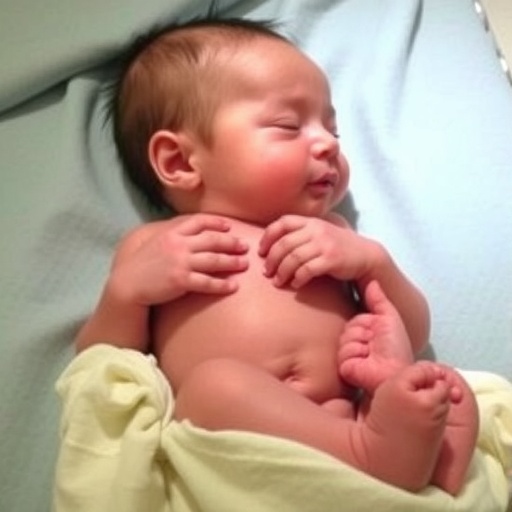In an era where neonatal care continues to evolve with groundbreaking discoveries, the practice of deferred cord clamping (DCC) in preterm neonates has emerged as a critical component influencing infant outcomes. A seminal study led by Chan, B., Ting, J.Y., Yoon, E., and their colleagues, recently published in the Journal of Perinatology, illuminates the complex interplay of maternal, neonatal, and hospital-related factors that dictate compliance rates with DCC protocols in infants born before 33 weeks of gestation. This extensive investigation brings to light not only the clinical benefits but also the systemic and procedural nuances that govern the implementation of this lifesaving intervention.
Deferred cord clamping, defined as the intentional delay in clamping the umbilical cord shortly after birth, has been associated with improved hematologic stability, reduced incidence of intraventricular hemorrhage, and better overall neonatal health, particularly in premature infants. This is due to the beneficial placental transfusion that continues post-delivery, augmenting the infant’s blood volume and benefiting fragile organ systems. Yet, despite growing evidence supporting DCC, adherence to practice guidelines remains inconsistent across various healthcare settings. Chan et al.’s study dissects these inconsistencies by deploying a rigorous multicenter cohort analysis that critically evaluates influencing variables.
The researchers’ methodology involved a detailed retrospective review of preterm deliveries under 33 weeks gestation across multiple tertiary care centers. They meticulously recorded DCC compliance rates, defined by whether the cord was clamped after a recommended period, typically ranging between 30 to 60 seconds post-delivery. The duration of compliance was also scrutinized to reflect both qualitative and quantitative adherence. By integrating maternal demographics, neonatal clinical status, and hospital procedural protocols into their analytical framework, the study reveals how each domain contributes to the observed variations in practice.
.adsslot_b5oYWVpgdr{ width:728px !important; height:90px !important; }
@media (max-width:1199px) { .adsslot_b5oYWVpgdr{ width:468px !important; height:60px !important; } }
@media (max-width:767px) { .adsslot_b5oYWVpgdr{ width:320px !important; height:50px !important; } }
ADVERTISEMENT
One of the notable findings revolves around maternal factors influencing DCC compliance. For instance, women exhibiting certain obstetric complications, such as preeclampsia or placental abruption, showed altered rates of DCC adherence. These conditions often necessitate expedited neonatal resuscitation, which may preclude the possibility of delayed clamp timing. Moreover, the study highlights that maternal age and parity also impact compliance, with younger mothers and multiparous women more likely to have DCC performed per protocol, potentially reflecting provider biases or institutional guideline adherence connected to demographic profiles.
Equally compelling are the neonatal variables that affect whether and how long DCC is applied. Neonatal heart rate variability, Apgar scores, and the immediate need for resuscitative interventions emerge as significant determinants. Infants requiring urgent respiratory support or exhibiting severe asphyxia at birth were less likely to undergo prolonged cord clamping. This aligns with clinical urgency; however, it also underscores the tension between the ideal and pragmatic aspects of neonatal care, warranting innovations in resuscitation protocols that could allow simultaneous support and effective DCC.
Hospital factors convey a powerful influence on DCC compliance, none more impactful than institutional policies and staff training. Facilities with clearly outlined protocols, regular training sessions, and audit mechanisms demonstrated markedly higher compliance rates and longer DCC durations. Interestingly, the presence of dedicated neonatal teams trained specifically in the nuances of DCC, as well as interprofessional collaboration between obstetric and neonatology units, correlated with improved adherence. This points toward the importance of harmonizing multidisciplinary approaches to optimize neonatal outcomes.
The research did not shy away from exploring logistical challenges within hospital settings that may impede DCC practices. Physical constraints such as delivery room design, availability of bedside resuscitation equipment, and staffing ratios directly influenced the feasibility of delayed clamping. Centers equipped with mobile neonatal resuscitation carts and adjustable beds to accommodate both maternal stabilization and infant care within proximity facilitated better compliance. This technical aspect often remains underacknowledged but is critical in translating guidelines into practice.
Beyond infrastructure, the study touches upon cultural and attitudinal barriers among healthcare providers. Variation in clinician awareness about evidence underpinning DCC and personal beliefs about risks and benefits create an environment of heterogeneous adoption. Providers entrenched in traditional immediate clamping practices showed resistance to protocol changes, while others championed DCC as a best practice. The psychological and educational dimensions of introducing new perinatal procedures are complex and need addressing through targeted continuing medical education and supportive leadership.
A fascinating element of this investigation lies in the temporal aspects of DCC compliance. The authors observed that compliance rates improved over time in centers actively engaged in quality improvement initiatives. This temporal trend suggests that educational efforts, policy reinforcement, and feedback loops foster better adherence, underscoring the dynamic nature of clinical practice transformation. Establishing sustainable behavior change within healthcare teams emerges as a cornerstone in elevating DCC standards.
The long-term clinical implications of the study cannot be overstated. Improved compliance with DCC protocols in preterm neonates holds the promise of reducing complications such as necrotizing enterocolitis and sepsis, in addition to enhanced neurodevelopmental outcomes. By identifying factors associated with compliance variability, this study opens avenues for tailored interventions that address specific barriers in different populations and care contexts.
From a public health perspective, the findings beckon health systems and policymakers to invest in structural enhancements and provider education while championing research translations into frontline practice. The study provocatively suggests that successful DCC implementation may serve as a proxy for overall quality of perinatal care, motivating stakeholders to consider DCC compliance rates in hospital performance metrics and accreditation standards.
Researchers also advocate for innovation in cord management technologies, such as devices enabling delayed clamping without interfering with resuscitation efforts, or neonatal warming units integrated with cord bedside care. These advances could mitigate some of the practical challenges impeding DCC adherence, especially in high-acuity deliveries. The study’s insights set the stage for interdisciplinary collaborations between clinicians, engineers, and policymakers to develop such solutions.
Critically, the ethical dimensions of infant care arise in the conversation about optimizing DCC. Balancing the marginal gains of delayed clamping against the immediacy of life-saving interventions presents a dilemma clinicians frequently face. Chan et al.’s work offers an evidence-based framework that can inform guidelines, emphasizing individualized clinical judgment while promoting standardized best practices whenever feasible.
In summary, the investigation enriches the neonatal field’s understanding of why deferred cord clamping remains variably practiced despite clear evidence benefits. By dissecting the maternal, neonatal, and hospital determinants shaping compliance, the study lays a foundation for comprehensive strategies to enhance DCC uptake. Its implications resonate across clinical, policy, and technological spheres, heralding a future where preterm neonates receive the full advantage of one of the simplest yet most impactful early life interventions.
With deferred cord clamping poised to become a universal standard for preterm deliveries under 33 weeks’ gestation, awareness and action stemming from this research are indispensable. Bridging the gap between evidence and practice through investment, education, and innovation could dramatically shift neonatal outcomes on a global scale. The work of Chan and colleagues thus serves as both a clarion call and a roadmap for improving early-life care in vulnerable populations worldwide.
Subject of Research: Maternal, neonatal, and hospital factors influencing deferred cord clamping compliance rates in preterm neonates under 33 weeks’ gestation.
Article Title: Factors associated with rates and durations of cord clamping practice compliance in preterm neonates of <33 weeks’ gestation.
Article References:
Chan, B., Ting, J.Y., Yoon, E. et al. Factors associated with rates and durations of cord clamping practice compliance in preterm neonates of <33 weeks’ gestation. J Perinatol (2025). https://doi.org/10.1038/s41372-025-02328-8
Image Credits: AI Generated
DOI: https://doi.org/10.1038/s41372-025-02328-8
Tags: adherence to cord clamping guidelinesclinical benefits of deferred cord clampingdeferred cord clamping in preterm infantsfactors influencing cord clampinghematologic stability in neonatesimplementation of DCC protocolsimproved outcomes for premature babiesintraventricular hemorrhage preventionmaternal and neonatal healthmulticenter cohort analysis in healthcareneonatal care practicessystemic factors in neonatal care





